Designers often need to measure and manage power consumption of low-voltage, high-power ICs such as FPGAs and GPUs to manage performance or anticipate problems. But this simple-sounding task has some implementation complexity and operational subtlety. The challenge is compounded when there’s also a need to know total energy use, which is a function of the aggregate (integral) of the instant-by-instant power value.
To address this problem, Microchip Technology developed the PAC1932/3/4, which are two, three, and four-channel power- and energy-monitoring ICs, respectively. Using a high-voltage multiplexer, this monitor continuously digitizes the dc rail (bus) voltage as well as the voltage across an external current-sense resistor, both with 16 bits of resolution. It then digitally computes the instantaneous power as a product of the two voltage readings (since the current can be inferred from the voltage across that resistor) and provides the results via I2C/SMBus interfaces, including an eight-sample average for reading stability.
The user-supplied sense resistor is chosen so that the maximum current to be measured reaches 100-mV full scale, with a 0- to 32-V common-mode voltage range. The IC can also be set to measure bidirectional current corresponding to a ±100-mV input scale, if needed, which is useful for charge/discharge applications. Measurement accuracy is 1% over a wide dynamic range. The ICs can measure voltage rails under 1 V to as high as 32 V. Thus, designers needn’t reconfigure the measurement resolution when going between low- and high-current load events.
The two-channel PAC1932 IC from Microchip enables simple inclusion of power- and energy-use measurement into circuit designs, which are needed to monitor these vital and often limited resources. The three- and four-channel versions are very similar, but support higher channel count.
The PAC1932 series provides more than just instantaneous power readings. Its offers on-chip accumulation to 28 bits of power results for energy measurement, with a 48-bit power accumulator register for recording accumulated power data and a 24-bit accumulator count.
Sampling rates are user-programmable at 8, 64, 256, and 1024 samples per second, allowing for up to 17 minutes of power data accumulation at 1024 samples/s and over 36 hours at 8 samples/s. The sampling rate and energy-integration period can be controlled via the SMBus or I2C interfaces, which can also be used for active channel selection, one-shot measurements, and other configuration control.
The ICs require a 2.7- to 5.5-V supply, and have a separate VDD I/O pin for digital I/O. They come in 4- × 4- × 0.5-mm UQFN packages, as well as a 2.225- × 2.17-mm WLCSP package for the four-channel PAC1934. The two-and three-channel PAC1932/33 work with Linux and Windows 10 software drivers. The PAC1932/33 is register-compatible with the ADM00805 evaluation board, which can be used to start development with a graphical user interface reporting sensed voltage, bus voltage, power, and accumulated power. Both the basic PAC1932 power-monitoring IC and the three-channel PAC1933 are available now, priced at $0.78 and $0.94 each, respectively, in 10,000-unit quantities.
About the Author

Bill Schweber
Contributing Editor
Bill Schweber is an electronics engineer who has written three textbooks on electronic communications systems, as well as hundreds of technical articles, opinion columns, and product features. In past roles, he worked as a technical website manager for multiple topic-specific sites for EE Times, as well as both the Executive Editor and Analog Editor at EDN.
At Analog Devices Inc., Bill was in marketing communications (public relations). As a result, he has been on both sides of the technical PR function, presenting company products, stories, and messages to the media and also as the recipient of these.
Prior to the MarCom role at Analog, Bill was associate editor of their respected technical journal and worked in their product marketing and applications engineering groups. Before those roles, he was at Instron Corp., doing hands-on analog- and power-circuit design and systems integration for materials-testing machine controls.
Bill has an MSEE (Univ. of Mass) and BSEE (Columbia Univ.), is a Registered Professional Engineer, and holds an Advanced Class amateur radio license. He has also planned, written, and presented online courses on a variety of engineering topics, including MOSFET basics, ADC selection, and driving LEDs.


